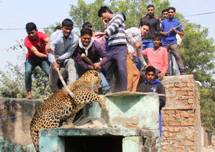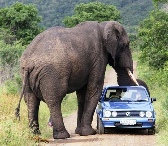THE CONUNDRUM OF HUMAN-WILDLIFE CONFLICT

It was daybreak, Saumitra and his friend were lazily strolling nearby the wooded areas in the periphery of their village when they came across a herd of elephants approximately 200 feet away. He could see roughly 15 or 16 of them, half juveniles and half adult females grazing the way they do, ripping branches off trees and gnawing them down. He had seen several herds of elephants doing this frequently, but this time he smelled some eerie hostility in the air. Before he could react, he suddenly saw a massive male elephant spin around, put his trunk in the air with his ears extended out, ululating and charging at them. Terrified, they tried to flee, but there’s no outrunning a seething rogue elephant. As he stood transfixed, Saumitra could see the grey, the hair follicles, the eyeball, the trunk, the tusk, the foot—the whole thing. Next thing Saumitra knew was that the elephant had hurled him into the air and then slammed him to the ground. Excruciating pain followed as the elephant’s tusk pierced through his left thigh, goring it, and ripping it out sideways. After a pause, the elephant lifted its leg and transferred its 6-ton body weight on the helpless 60kg man lying on the ground crushing his ribs and snuffing out his life instantaneously just the way we unknowingly trample small insects under our feet when we step on them.
Wild animals can become more terrifying than the most dreaded terrorists like Osama Bin Laden when we put a growing squeeze on their habitat. Expanding human and animal populations, shrinking forests, and the proliferation of invasive species is evolving into a confrontation that has the potential to develop into a full-blown battle. The terror unleashed by the elephant that killed Saumitra earned him the name Osama bin Laden as a barb to the dreaded terrorist. He was a rogue bull elephant liable for at least 27 deaths and devastation of property in the jungles of the Sonitpur district of the state of Assam. After a two-year rampage from 2004 to 2006, the authorities shot the elephant dead.
 Likewise, Avni was a six-year-old tigress suspected of having killed 13 people over two years in the hills of central India. A hunter was engaged for tranquillising the tigress with a dart. But when the tigress despite the dart began charging at the hunter, the hunter yanked the trigger of his gun and brought the beautiful beast down. Just a day after they exterminated Avni, another tigress in Uttar Pradesh was run over and beaten to death by furious locals after she mauled a 50-year-old man. A few days later another majestic tigress Sundari that was blamed for killing a woman in Orissa was relocated to Nandankanan zoo.
Likewise, Avni was a six-year-old tigress suspected of having killed 13 people over two years in the hills of central India. A hunter was engaged for tranquillising the tigress with a dart. But when the tigress despite the dart began charging at the hunter, the hunter yanked the trigger of his gun and brought the beautiful beast down. Just a day after they exterminated Avni, another tigress in Uttar Pradesh was run over and beaten to death by furious locals after she mauled a 50-year-old man. A few days later another majestic tigress Sundari that was blamed for killing a woman in Orissa was relocated to Nandankanan zoo.
Is it right on our part to call Avni a man-eater? Because man-eaters don’t transgress into our habitats, it’s we who trespass into their habitat. Tigers are solitary and require vast territories —Are we not supposed to respect and honour their territories? When we dishonour and trespass into their territories, they have no option but to attack humans. We have lost 95 percent tigers since the 20th century started, we now have only 3900 tigers left. Now the tigers require us more than ever. If it is so, is it not our responsibility to respect their territories, and let them live in peace and protect them and not trespass into them as tourists or as hunters to poach them?
 Elephants and tigers are slaying one person a day in India as humans are constricting their habitat. According to the environment ministry, 1,144 people got killed in attacks on India in 1,143 days between April 2014 And May 2017. And man is slaughtering a leopard a day as the man-animal struggle for space is growing to enormous proportions as India continues to forfeit vast swathes of wooded areas to urbanisation in contemporary decades, pushing animals into human-occupied zones.
Elephants and tigers are slaying one person a day in India as humans are constricting their habitat. According to the environment ministry, 1,144 people got killed in attacks on India in 1,143 days between April 2014 And May 2017. And man is slaughtering a leopard a day as the man-animal struggle for space is growing to enormous proportions as India continues to forfeit vast swathes of wooded areas to urbanisation in contemporary decades, pushing animals into human-occupied zones.
When we get down to Tamil Nadu, the predicament is no different. Every day when the West Zone Inspector General of Police routinely gives the daily situation report to me I get to hear at least two to three cases of the human-animal conflict every week in which they kill or maim a human especially in the Nilgiris. Most of them being because of elephants entering farmer’s fields. The Forest Department attributes this to a shift in land-use pattern and crop cultivation close to reserve forest tracts.
 Likewise, we get to see a rise in human-animal conflict during droughts and summer as a scarcity of water drives the animals to the periphery bringing them in conflict with humans. Increased cultivation of animal-enticing cash crops such as sugarcane is reported to have increased the conflict near Sathyamangalam Tiger Reserve and Rajapalayam. Frequent forays of humans into the wilderness seem to have familiarised these animals far too much with humans.
Likewise, we get to see a rise in human-animal conflict during droughts and summer as a scarcity of water drives the animals to the periphery bringing them in conflict with humans. Increased cultivation of animal-enticing cash crops such as sugarcane is reported to have increased the conflict near Sathyamangalam Tiger Reserve and Rajapalayam. Frequent forays of humans into the wilderness seem to have familiarised these animals far too much with humans.
Screaming, wailing, howling, bursting firecrackers, beating drums, bonfires and letting ferocious hounds do not seem to have made any impact on the wildlife ravaging the crops or human habitats. Wild animals continue to plummet into wells; elephants continue to trample humans; wild boars continue to cause havoc in agricultural farms, leopards continue to maul cattle and humans with rising regularity due to the infringement of wildlife corridors which is making migration of animals along the traditional corridors impossible or fragmented.
The data from the State forest department and the Ministry of Environment, Forests and climate change of India, contends that in Tamil Nadu alone, the human-animal conflict has claimed at least 185 human lives, and over 132 lives of elephants and tigers between 2013 and 2016. This data does not take into account monkeys, leopards, rabbits, deers, bears, and other animals that are also regularly entering conflict with humans.
 One explanation why the Nilgiris region has seen a rapid increase in incidents of human-wildlife conflict is because the area has witnessed the proliferation of invasive plant species. Invasive plants are plant species that got introduced from various parts of the world and thrive at the cost of native diversity. Eleven of the world’s 100 harmful invasive species are now found in India. Several of them such as Lantana camara, Parthenium hysterophorus, Prosopis juliflora have mushroomed inside protected tracts causing antagonistic consequences on forest soil such as the banishment of native species on which local herbivores such as elephants, gaur, and wild boar depend on for food. All three exotic species are inedible, and some, such as the Parthenium, are harmful to herbivores. Prosopis can be toxic as well and cause severe indigestion and tooth decay to wildlife. They found traces of Prosopis in elephants that reportedly died of starvation at the state’s Mudumalai Tiger Reserve, and in another dead elephant found near Thengumarahada.
One explanation why the Nilgiris region has seen a rapid increase in incidents of human-wildlife conflict is because the area has witnessed the proliferation of invasive plant species. Invasive plants are plant species that got introduced from various parts of the world and thrive at the cost of native diversity. Eleven of the world’s 100 harmful invasive species are now found in India. Several of them such as Lantana camara, Parthenium hysterophorus, Prosopis juliflora have mushroomed inside protected tracts causing antagonistic consequences on forest soil such as the banishment of native species on which local herbivores such as elephants, gaur, and wild boar depend on for food. All three exotic species are inedible, and some, such as the Parthenium, are harmful to herbivores. Prosopis can be toxic as well and cause severe indigestion and tooth decay to wildlife. They found traces of Prosopis in elephants that reportedly died of starvation at the state’s Mudumalai Tiger Reserve, and in another dead elephant found near Thengumarahada.
Hence wild animals stray into planters fields more often because of the lack of better fodder in the wild. Most invasive species create a dense, rough, and thick undergrowth in the forest, as these species, particularly Lantana and parthenium, grow as thickets with hardly any space between them. This impedes the movement of large animals, both herbivores and carnivores, and obstructs their access to both their ancestral activity corridors and to food sources.
Furthermore, plantations of the forest department have been further aggravating this effect. Species such as Acacia and Eucalyptus have been decreasing the water table levels further benefiting exotics that are better adapted to drier environments. A resin-like substance that trickles from such foreign species renders the soil acidic, hindering the growth of any other plant species. In the Western Ghats, where vast plantations of eucalyptus and wattle got raised in the past by changing grasslands and shola forests, has led to the devastation of the original habitat of the Nilgiri Tahr.
Further, the ban on cattle grazing also appears to have contributed to the development of undergrowth and a loss of dung and cattle manure, which is a source of nourishment for native species leading to a decline of native species. Therefore, a situation emanating from lack of edible plants inside forests and hampering of movement inside the woods has compelled both carnivores and herbivores to go outside jungles in search of food. Under such circumstances, farming fields have become very attractive to large herbivores such as the deer and elephants as they find the fields crammed with edible plants. Predators, in turn, pursue the herbivores out of the wilderness to hunt them for food as a result they come in conflict with the humans. Presently, the Indian Bison visits the Kodaikanal town in Tamil Nadu because of the non-availability of food plants because of the extensive plantations of alien species.
Therefore , human-wildlife conflicts are having enormous consequences. Such confrontations have been giving rise to hostility, vexation, resentment and alienation. Most families are suffering crop losses from wildlife invasions. The animals that most often obliterate crops are elephants, deer, pigs and monkeys. Pigs mostly raid root vegetables and subterranean crops. Most of these animals attack crops at night, hence defending crops against destruction is difficult. The farmers to protect the crops have to stay awake at night. Farmer’s families resort to a rotational guarding of fields with substantial health impacts such as sleep deprivation or disruption in daily schedules.If animals overrun the fields when the crop is ready for harvest, the result is the destruction of several months of work. Continual guarding takes a toll on health and makes travel or migration difficult. Not just crop losses, livestock losses also happen frequently in such areas. Losing cattle or buffaloes, goats, and dogs are also common. Such losses make more impact than crop losses because cows, goats, and buffaloes embody several years’ worth of investment or savings. And antidotes for such losses veer around steps like fences, guarding, and so on to diminish wildlife entry into human habitation or fields, or “compensation” for those affected, injured, or killed by wildlife. Those most affected by human-wildlife conflict seem to be the forest dwellers or the farming communities that live near the forests.
The forest department extends peanuts as compensation to the affected victims of crop loss. The compensation ranges from Rs 5,000 to Rs 10,000. To receive the benefit provided by the forest department for crop loss because of pillaging animals, the victims have to go through a long-winded bureaucratic procedure. The authorities process the claims of the victims only after they furnish a certificate by the village administrative officer and the agricultural officer. Compensation for death or permanent disability as an outcome of an attack by a wild animal is more straightforward, though. It varies between Rs 20,000 and Rs 1 lakh with disability and Rs 3 lakhs to Rs 5 lakhs in case of death. Wildlife attacks are one rationale for migration out of place. When an elephant trampled the breadwinner of a family in the Nilgiris, the remaining family members shifted to Coimbatore city shortly afterwards.
The human-wildlife conflict is a feature of almost all forested landscapes in India. The cause behind most conflicts as we have seen is the burgeoning population of both humans and animals, resulting in enormous competition for land leading to contraction of the habitat of the animals and also due to an increase in development projects. India, at the moment, would do well if it handled the conflict by engaging the affected communities and by vigorously safeguarding the existing habitats of animals from human interference. The approach being adopted today appears ineffective as we base it on reactive measures. A proactive measure, such as engaging the community, would portend well for diluting the conflict.
Use of a more straightforward, cost-effective early warning system (SMS alerts) as used in Valparai of notifying the presence of elephants could get replicated in other parts of India to ease the way to coexistence. To tackle the problem of man-human conflict, governments may have to undertake a rapid modernisation of Forest departments. Bigger budgets and the creation of better infrastructures will strengthen the hands of the forest department to ward off attacks by using modern techniques such as GIS, drones, lasers, scanners, DNA fingerprinting, infra-red sensors, 3D sensing and imaging. Deployment of drones and the use of AI could predict animal movements accurately, and the use of robots to chase or guide the direction of movement of wild animals could also be contemplated.
Are animals spiritual beings like human beings? Do they possess a spiritual nature? The Mahayana School of Buddhism, believe animals possess Buddha nature and therefore have an equal potential to become enlightened. The Buddha further expounded that those sentient beings living in the animal domain have been our mothers, brothers, sisters, fathers, children, and friends in past rebirths. One cannot, therefore, make a difference between the spiritual rules applicable to animals and those relevant to humans: humans and animals are eventually part of a single-family. We are all interconnected so let us, therefore, live in harmony without conflict and protect each other.
Source from: epaper/deccanchronicle/chennai/dt:24.02.2020
 Dr.K. Jayanth Murali is an IPS Officer belonging to 1991 batch. He is borne on Tamil Nadu cadre. He lives with his family in Chennai, India. He is currently serving the Government of Tamil Nadu as Additional Director General of Police, Law and Order.
Dr.K. Jayanth Murali is an IPS Officer belonging to 1991 batch. He is borne on Tamil Nadu cadre. He lives with his family in Chennai, India. He is currently serving the Government of Tamil Nadu as Additional Director General of Police, Law and Order.


